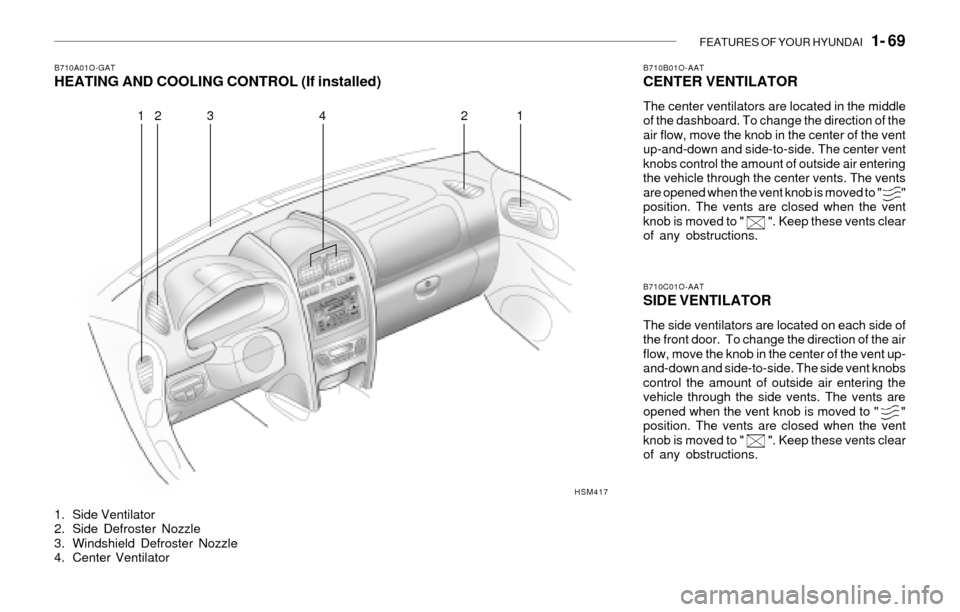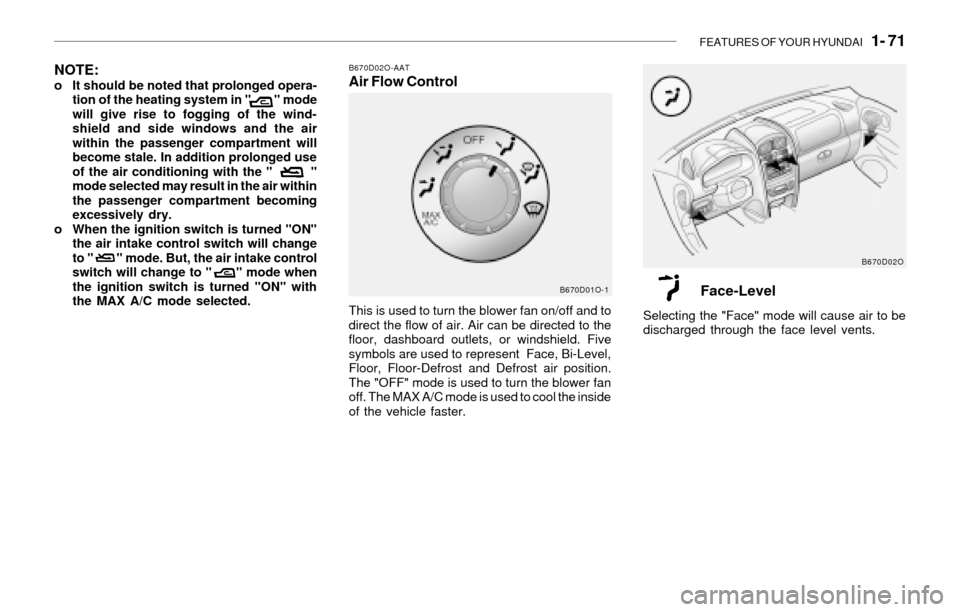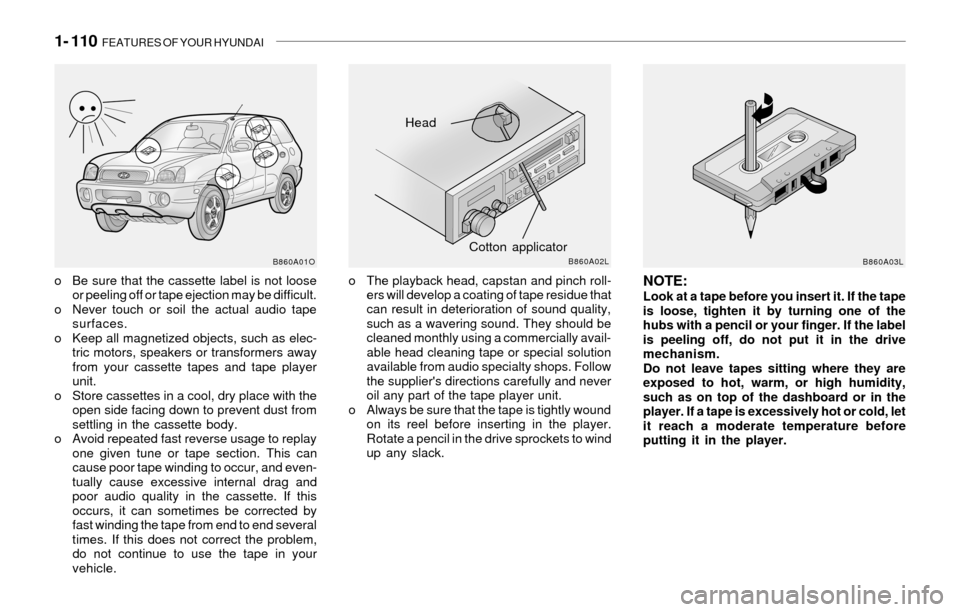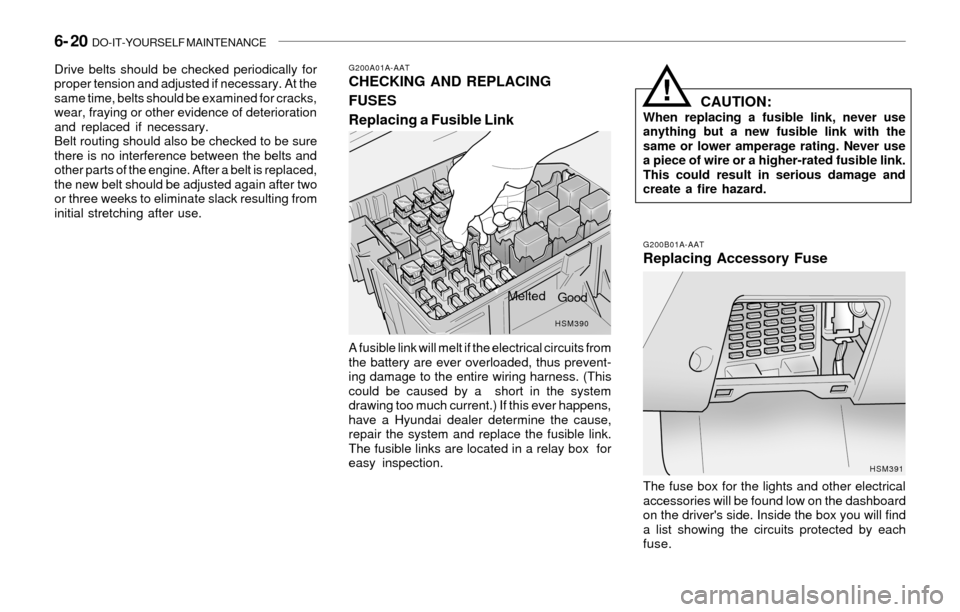Page 81 of 221

FEATURES OF YOUR HYUNDAI 1- 69
HSM417 B710A01O-GAT
HEATING AND COOLING CONTROL (If installed)
1. Side Ventilator
2. Side Defroster Nozzle
3. Windshield Defroster Nozzle
4. Center Ventilator
B710B01O-AATCENTER VENTILATOR
The center ventilators are located in the middle
of the dashboard. To change the direction of the
air flow, move the knob in the center of the vent
up-and-down and side-to-side. The center vent
knobs control the amount of outside air entering
the vehicle through the center vents. The vents
are opened when the vent knob is moved to " "
position. The vents are closed when the vent
knob is moved to " ". Keep these vents clear
of any obstructions.
B710C01O-AATSIDE VENTILATOR
The side ventilators are located on each side of
the front door. To change the direction of the air
flow, move the knob in the center of the vent up-
and-down and side-to-side. The side vent knobs
control the amount of outside air entering the
vehicle through the side vents. The vents are
opened when the vent knob is moved to " "
position. The vents are closed when the vent
knob is moved to " ". Keep these vents clear
of any obstructions.
12 3 4 12
Page 83 of 221

FEATURES OF YOUR HYUNDAI 1- 71
B670D02O-AATAir Flow Control
This is used to turn the blower fan on/off and to
direct the flow of air. Air can be directed to the
floor, dashboard outlets, or windshield. Five
symbols are used to represent Face, Bi-Level,
Floor, Floor-Defrost and Defrost air position.
The "OFF" mode is used to turn the blower fan
off. The MAX A/C mode is used to cool the inside
of the vehicle faster.
B670D01O-1B670D02O
NOTE:o It should be noted that prolonged opera-
tion of the heating system in " " mode
will give rise to fogging of the wind-
shield and side windows and the air
within the passenger compartment will
become stale. In addition prolonged use
of the air conditioning with the " "
mode selected may result in the air within
the passenger compartment becoming
excessively dry.
o When the ignition switch is turned "ON"
the air intake control switch will change
to " " mode. But, the air intake control
switch will change to " " mode when
the ignition switch is turned "ON" with
the MAX A/C mode selected.
Face-Level
Selecting the "Face" mode will cause air to be
discharged through the face level vents.
Page 84 of 221
1- 72 FEATURES OF YOUR HYUNDAI
Bi-Level
Air is discharged through the face vents and the
floor vents. This makes it possible to have
cooler air from the dashboard vents and warmer
air from the floor outlets at the same time.
B670D03O
Floor-Defrost Level
Air is discharged through the windshield de-
froster nozzle, the floor vents, side defroster
nozzle and side ventilator.
If the "Floor-Defrost" mode is selected, the A/C
will turn on automatically and "Fresh" mode will
be activated.
Floor-Level
Air is discharged through the floor vents, wind-
shield defroster nozzle, side defroster nozzle
and side ventilator.
If the "Floor" mode is selected, the "Fresh"
mode will be activated.
HSM118HSM119
Page 87 of 221
FEATURES OF YOUR HYUNDAI 1- 75
To operate the ventilation system:
o Set the air intake control switch to the fresh
air ( ) position.
o To direct all intake air to the dashboard
vents, set the airflow control to the face ( )
position.
o Adjust the fan speed control to the desired
speed.
o Set the temperature control between "Cool"
and "Warm".
B710A01O-AATVENTILATIONB700A01O-AATBI-LEVEL HEATING
Your Hyundai is equipped with bi-level heating
controls. This makes it possible to have cooler
air from the dashboard vents and warmer air
from the floor outlets at the same time. To use
this feature:
o Set the air intake control switch to the fresh
air ( ) position.
o Set the air flow control at the bi-level ( )
position.
o Set the temperature control between "Cool"
and "Warm".
B700A01O-1B710A01O-1
B740A01S-AATAIR CONDITIONING SYSTEM
Air Conditioning Switch
The air conditioning is turned on or off by
pushing the A/C button on the heating/air con-
ditioning control panel.
B740A01O
Page 93 of 221
FEATURES OF YOUR HYUNDAI 1- 81
B980E01O-AATAir Flow Control
B670D02O
Face-LevelWhen selecting the "Face-Level", the indicator
light will come on, causing air to be discharged
through the face level vents. This is used to direct the flow of air. Air can be
directed to the floor, dashboard outlets, or
windshield. Four symbols are used to represent
Face, Bi-Level, Floor and Floor-Defrost posi-
tion.
HSM218
B670D03O
Bi-Level
When selecting the "Bi-Level", the indicator light
will come on and the air will be discharged
through the face vents and the floor vents. This
makes it possible to have cooler air from the
dashboard vents and warmer air from the floor
outlets at the same time.
Page 122 of 221

1- 110 FEATURES OF YOUR HYUNDAI
o Be sure that the cassette label is not loose
or peeling off or tape ejection may be difficult.
o Never touch or soil the actual audio tape
surfaces.
o Keep all magnetized objects, such as elec-
tric motors, speakers or transformers away
from your cassette tapes and tape player
unit.
o Store cassettes in a cool, dry place with the
open side facing down to prevent dust from
settling in the cassette body.
o Avoid repeated fast reverse usage to replay
one given tune or tape section. This can
cause poor tape winding to occur, and even-
tually cause excessive internal drag and
poor audio quality in the cassette. If this
occurs, it can sometimes be corrected by
fast winding the tape from end to end several
times. If this does not correct the problem,
do not continue to use the tape in your
vehicle.NOTE:Look at a tape before you insert it. If the tape
is loose, tighten it by turning one of the
hubs with a pencil or your finger. If the label
is peeling off, do not put it in the drive
mechanism.
Do not leave tapes sitting where they are
exposed to hot, warm, or high humidity,
such as on top of the dashboard or in the
player. If a tape is excessively hot or cold, let
it reach a moderate temperature before
putting it in the player.
Head
Cotton applicator
B860A01OB860A02LB860A03L
o The playback head, capstan and pinch roll-
ers will develop a coating of tape residue that
can result in deterioration of sound quality,
such as a wavering sound. They should be
cleaned monthly using a commercially avail-
able head cleaning tape or special solution
available from audio specialty shops. Follow
the supplier's directions carefully and never
oil any part of the tape player unit.
o Always be sure that the tape is tightly wound
on its reel before inserting in the player.
Rotate a pencil in the drive sprockets to wind
up any slack.
Page 190 of 221

6- 20 DO-IT-YOURSELF MAINTENANCE
!
G200A01A-AATCHECKING AND REPLACING
FUSES
Replacing a Fusible Link
G200B01A-AATReplacing Accessory Fuse
A fusible link will melt if the electrical circuits from
the battery are ever overloaded, thus prevent-
ing damage to the entire wiring harness. (This
could be caused by a short in the system
drawing too much current.) If this ever happens,
have a Hyundai dealer determine the cause,
repair the system and replace the fusible link.
The fusible links are located in a relay box for
easy inspection.
CAUTION:When replacing a fusible link, never use
anything but a new fusible link with the
same or lower amperage rating. Never use
a piece of wire or a higher-rated fusible link.
This could result in serious damage and
create a fire hazard.
The fuse box for the lights and other electrical
accessories will be found low on the dashboard
on the driver's side. Inside the box you will find
a list showing the circuits protected by each
fuse.
HSM390
HSM391
Melted
Good Drive belts should be checked periodically for
proper tension and adjusted if necessary. At the
same time, belts should be examined for cracks,
wear, fraying or other evidence of deterioration
and replaced if necessary.
Belt routing should also be checked to be sure
there is no interference between the belts and
other parts of the engine. After a belt is replaced,
the new belt should be adjusted again after two
or three weeks to eliminate slack resulting from
initial stretching after use.